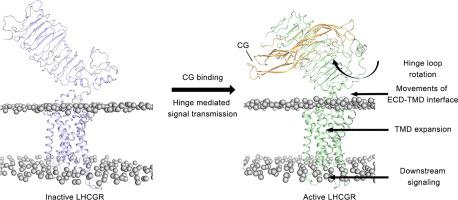Computational and Structural Biotechnology Journal ( IF 4.4 ) Pub Date : 2022-11-22 , DOI: 10.1016/j.csbj.2022.11.039 Xinheng He 1, 2 , Jia Duan 1, 2 , Yujie Ji 1, 2 , Lifen Zhao 1 , Hualiang Jiang 1, 2, 3, 4, 5 , Yi Jiang 4, 5 , H Eric Xu 1, 2 , Xi Cheng 1, 2, 3

|
Luteinizing hormone-choriogonadotropin receptor (LHCGR), a class A G protein-coupled receptor (GPCR), plays a pivotal role in the maturation of reproductive organs and embryonic development. Compared with other GPCRs, the subfamily of LHCGR has a large extracellular domain (ECD) to interact with glycoprotein hormones. A unique hinge region connects the ECD and transmembrane domain (TMD) to transfer the activation signal. However, the signal transmission mechanism remains largely unknown. Here, both molecular dynamics simulation and evolutional analysis were applied to explore the effect of the hinge region on signal transmission. The glycoprotein hormone determined specific hinge region conformations, including the position of a long hinge loop and the ECD-TMD interface. With the hormone, the hinge region showed a characteristic rotation and displayed an active-like conformational landscape of the ECD-TMD interface with an extended TMD. The active-like hinge region conformation transduces the hormone binding signal downwards from ECD to TMD. The relationship between the hinge region and the intracelluar G protein-binding pocket was also inferred. The hinge region-mediated signal transmission mechanism offers a deeper understanding of LHCGR and provides insights into the elucidation of GPCR activation.
中文翻译:

铰链区介导促黄体激素和绒毛膜促性腺激素受体的信号传递
黄体生成素-绒毛膜促性腺激素受体 (LHCGR) 是一种 AG 类蛋白偶联受体 (GPCR),在生殖器官的成熟和胚胎发育中起着关键作用。与其他 GPCR 相比,LHCGR 亚家族具有较大的细胞外结构域 (ECD),可与糖蛋白激素相互作用。独特的铰链区连接 ECD 和跨膜域 (TMD) 以传递激活信号。然而,信号传输机制在很大程度上仍然未知。在这里,应用分子动力学模拟和进化分析来探索铰链区对信号传输的影响。糖蛋白激素决定了特定的铰链区构象,包括长铰链环和 ECD-TMD 界面的位置。有了激素,铰链区域显示出特征性旋转,并显示出具有扩展 TMD 的 ECD-TMD 界面的活性状构象景观。类活性铰链区构象将激素结合信号从 ECD 向下转导至 TMD。还推断了铰链区和细胞内 G 蛋白结合袋之间的关系。铰链区介导的信号传输机制提供了对 LHCGR 的更深入理解,并提供了对 GPCR 激活阐明的见解。











































 京公网安备 11010802027423号
京公网安备 11010802027423号